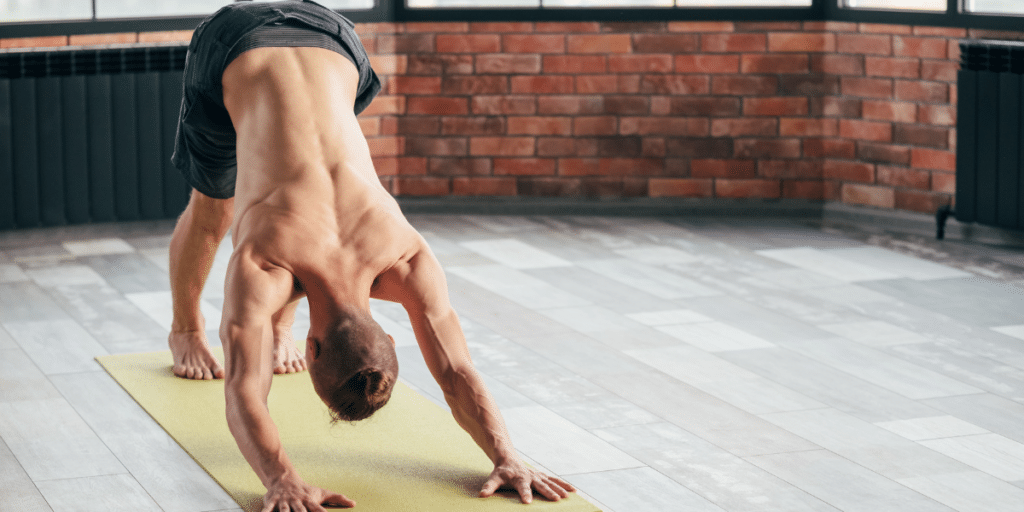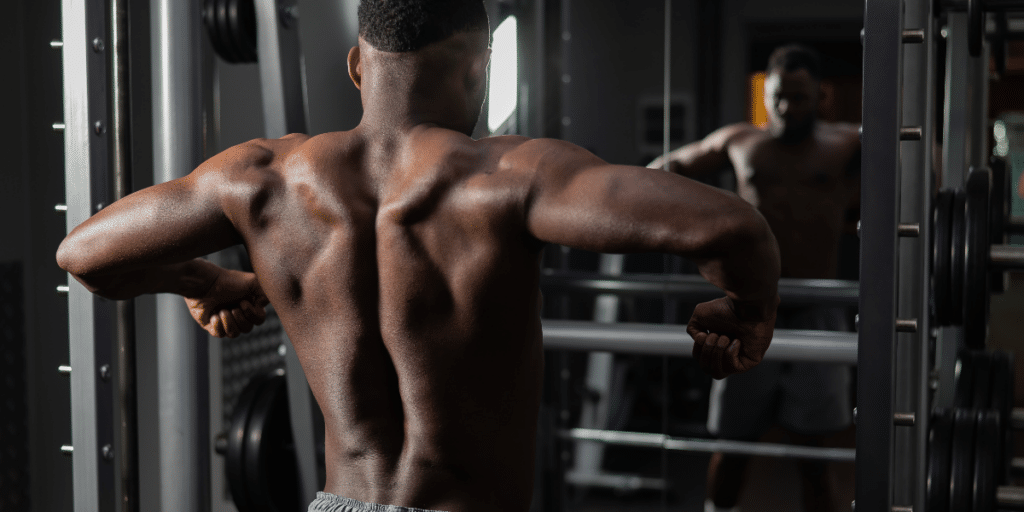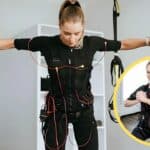In the quest for a well-rounded fitness routine, the significance of a strong back often takes center stage. Beyond aesthetic appeal, a robust back plays a pivotal role in posture, stability, and overall athleticism. Whether you’re aiming for better performance or enhanced well-being, prioritizing back exercises can pave the way to a healthier you.
Jump to:
9 Efficient Bodyweight Back Exercises To Build Stability
Exercising and movement are the best to build stability and prevent back pain.
1. Supermans
Supermans focus on the upper and lower back, including the intrinsic back muscles. This exercise also strengthens your glutes, shoulders, and deep core muscles.
How to do supermans:
1: Lie face-down on your stomach with your arms and legs extended.
2: Pull your abs away from the floor and toward your spine while lifting your arms and legs. Make sure to maintain your abdominal connection throughout the move.
3: Maintain this position for 5 seconds and lower your arms and legs back to the floor.
You can also make supermans easier on your neck by moving your arms to a Y or the side to form a T.
2. Y Raise
Y raises are an excellent opportunity to build your mind-muscle connection. Focus on squeezing your shoulders and keeping a superb posture throughout this exercise.
How to do Y raises:
1: While standing with your feet shoulder-width apart, hinge at the hips to lean forwards with slightly bent knees and straight backs. Dangle your arms down in front of your body.
2: Keep your hands in a neutral position with palms facing each other. Then point your thumbs up, activate your shoulders, and raise your arms into a “Y” shape.
3. Inverted Row
The inverted row exercise focuses on the upper and mid-back muscles, including the back’s extrinsic muscles. It also strengthens the core and arms. You can do inverted rows using a smith machine, the barbell on a squat rack, or a fixed bar or railing.
How to do inverted rows:
1: Set the bar high enough to extend your arms when lying down entirely.
2: Lying on your back under the bar, grab the bar with an overhand grip, and hang at a 45-degree angle.
3: Engage your core and pull your body towards the bar. Your body should barely touch the bar at the top of the exercise. Keep your body straight with your heels in constant contact with the floor.
To increase the difficulty, place your heels on an elevated surface.
4. Pullup
The prone pullup is a master exercise for building back strength and for a good reason. It’s simple but gives excellent results.
Directions:
1: Grab the pullup bar with a pronated grip and straight arms.
2: Activate your lats and arm muscles and pull up until the bar is at chest height.
3: Slowly lower your body back to the starting position in a controlled movement.
Pullups can be done with just your body weight or by adding weights to your waist or ankle to make this a free-weight back exercise.
5. Pushups
The pushup is another well-known back exercise. This exercise builds back strength and helps build arm extensor muscle strength. It’s also an excellent upper chest exercise.
Directions:
1: Start on your hands and feet with your hands apart at shoulder height, feet together, and legs fully extended. Keep your glutes and core tight to maintain a back straight.
2: Bend your elbows and lower your torso towards the floor, squeezing your back at the bottom of the movement.
3: Squeeze your chest to push yourself back to the starting position.
6. Side Plank Reach-to-Row
As a muscular endurance exercise, this side plank exercise also adds a rowing motion to build upper limb strength. The side plank reach-to-row is also a great core workout.
How to do side plank reach-to-row:
1: Prop into a side plank position with bent elbows and straight legs with feet stacked on each other. Make sure to tighten your core for excellent form.
2: Reach out with your free arm, fully extending before performing the rowing motion. Drive through the forearm and keep your hips off the floor without rotating them.
To improve stability, press your forearm and hand, palm down, into the floor to more efficiently create maximum tension in your shoulders and lat muscles. You can also make this a band exercise with an exercise band for a more advanced back exercise or to add some variety to your body workout.
7. Bird Dog
The bird dog exercise works the upper, mid-, and lower back muscles, including the spinal erectors and extrinsic back muscles. The bird dog is also a glute activation exercise that helps tone the core and shoulder muscles.
How to do bird dogs:
1: Start on your hands and knees, under your hips and shoulders.
2: Activate your core while extending your left leg back and right arm forward into an elevated position. Only lift your leg and arm position until they parallel the floor so you don’t overarch your back.
3: Pause at the top of the exercise and then slowly lower your arm and leg to the start.
6 Yoga Positions to Help with Back Soreness

Other exercises can also help our back. Yoga can be a good option for people with back pain or soreness because it gently stretches and strengthens your back muscles. Keep reading to learn a few yoga positions that improve back strength and comfort.
Cat/Cow
The cat/cow position is fantastic for stretching and mobilizing the spine. It also works the torso, shoulders, and neck.
How to do cat/cow:
1: Get down with knees and hands under shoulders and hips. Balance your weight on these four points.
2: Inhale as you look up and let your stomach bow towards the floor.
3: Exhale as you tuck your chin into your chest, tuck your belly button into your spine, and arch your back upwards.
4: Meditate and release body tension. Continue this movement back and forth for at least 1 minute.
Half Locust
The half locust pose is a simpler version of the locust pose and stretches the lower back and legs.
How to do half locust:
1: Lie on the floor with your hands under your thighs and chin on the floor.
2: Inhale and lift one leg as high as possible while keeping the other leg straight and on the floor.
3: Keep the position as long as it is comfortable, then return to the starting position.
4: Repeat with the other leg.
Cobra pose
The cobra pose stretches and strengthens your spine, critical for improving posture and soothing back pain.
How to do cobra pose:
1: Lying with your face on the yoga mat, place both hands on either side of the ribcage.
2: With your legs together, press your toes into the floor. Reach back through your toes, lengthen your legs, and push through your hands as your arms straighten with elbows touching your ribcage.
3: Using your back strength instead of your arms, lift your head and chest while sliding your shoulder blades down your back.
4: Take five to ten deep breaths before releasing to the floor while turning your head to one side.
Lying Down Spinal Twist
Also known as the supine twist, this yoga pose eases lower back tension by opening your hips.
How to do lying down spinal twist:
1: Lie down with your back on the exercise mat and your knees pulled up to your chest and bent to the left, resting on the ground with your right knee resting on the left knee. Don’t force your legs onto the floor if you feel pain in your back. You can add a pillow or block under your left knee for support.
2: Stay in this position for one or two minutes.
3: Repeat on the other side.
Sphinx Pose
The sphinx pose strengthens the spine and butt. It also stretches the chest, shoulders, and back and may reduce stress.
How to do sphinx pose:
1: Lying face down with your forehead touching the floor, place both hands at shoulder height, and engage your lower back, butt, and thigh muscles.
2: Slowly raise your torso and head while engaging your lower abs to support your back. Make sure to lift through your spine and out the crown of your head instead of collapsing into your lower back.
3: Keep looking forward as you relax into the pose, and maintain the position for 5 minutes.
Child’s Pose
The child’s pose helps with back soreness because it lengthens the sides of your body. It also provides gentle traction on the spine and brings focus to the body’s midline.
How to do child’s pose:
1: Kneel onto your hands and knees.
2: Put two blocks in front of you, shoulder-width apart, and place your palms on the blocks.
3: Push down on the blocks while pushing your hips back towards your feet.
Benefits of Doing Bodyweight Back Exercises Regularly

Besides preventing or improving back pain, doing bodyweight-only back exercises also provides other benefits including improved posture, stronger core muscles, building lean muscle, and sculpted back muscles. Keep reading to see why bodyweight exercises should be part of your daily tasks and exercise routine.
Improved Posture
Bodyweight back exercises are an excellent way to improve posture because they strengthen the key muscles we use to help maintain proper posture. Improving posture can also help reduce back pain in and of itself.
Stronger Core
Bodyweight back exercises help to strengthen your inner core as well. Activating your abdominal muscles is a necessary part of every exercise suggested, which helps build those core muscles. And, strengthening your abs is another way to reduce or prevent back pain, as doctors have found a link between a weak core and back pain.
Build Lean Muscle
Regular exercise can help build lean muscle, which comes with many benefits. Lean muscle mass improves overall posture, which reduces the risk of injury to bones, ligaments, and tendons. Surprisingly, lean muscle also strengthens your immune system.
Sculpt Your Back Muscles
Regularly doing bodyweight workouts will help build your back muscle mass; over time, your back will begin to look more sculpted. Not only will sculpted back muscles make you look more attractive with better posture, but standing straighter also makes you look more confident.
What Can Cause Back Pain?

Finding the cause of back pain can be complicated. The pain can differ based on the location. Additionally, nerves can also cause back pain. Let’s look at how location and nerves play a part in the cause of back pain.
Upper Back Pain
The most common cause of upper back pain is hunching, poor posture, and stress. If you sit at your day job or don’t get much exercise, your upper back muscles can become tight from lack of use.
Another common cause includes sprains and strains. One can easily injure the upper back muscles, tendons, or ligaments when lifting something too heavy or participating in explosive exercises. Poor posture, disc issues, fractures, and arthritis can also be reasons for upper back pain.
Lower Back Pain
Some causes of lower back pain are arthritis, back injuries, and disc problems. Arthritis is the most common cause of lower back pain. As we age, our spinal joints and the cartilage in our vertebral column begin to deteriorate causing pain as the vertebrae rub together.
A fall or accident can also cause injuries that cause lower back pain. But injuries can also come from something simple, like picking up a gallon of milk. Back injuries can occur suddenly or happen slowly over time. Ultimately, any tasks done repetitively or improperly can lead to bone or muscle damage.
Finally, one of the most commonly discussed causes is disc problems because they often happen suddenly, cause intense, debilitating pain, and are challenging to manage. A bulging or herniated disc occurs when two vertebrae compress together and force the “cushioning disc” between them to bulge or spill out causing pain and discomfort. Disc problems most commonly occur in the lower back.
Nerve Pain
Nerve pain can also be a cause of back pain. You might have nerve pain in your lumbar muscles, which causes pain in the lower back and legs, brachial area, which causes pain in the neck, shoulders, and arms, or thoracic spine.
Causes of nerve pain can include arthritis, bone spurs, inflammation, degenerative spinal issues, disc problems, spondylosis, spinal injury or infection, and abnormalities such as tumors, cysts, hernias, or hematomas.
How Bodyweight Back Exercises Can Prevent Back Pain
The best way to prevent back pain is to maintain a neutral spine and keep your back muscles strong, so bodyweight exercises are an excellent way to avoid back pain.
Make sure you have good form. Although strengthening your back muscles will help prevent back pain, injured or strained muscles would reverse your efforts. Remember, if you have back pain or an injury, consult a doctor before beginning a new workout.
FAQs About Bodyweight Back Exercises
You’ve learned much about bodyweight back exercises and their excellent benefits for preventing and reducing pain. Hopefully, we’ve answered most of your questions. But if not, some of these frequently asked questions may address any lingering queries.
Is It Safe to Do Bodyweight Back Exercises with Back Pain?
Yes, bodyweight back exercises are safe for back pain and an excellent way to stretch and build back muscle. But consult your personal trainer or physical therapist to ensure you won’t cause further pain or injury. If you do feel pain while exercising, try to rest between sets or for a minute between exercises.
Are Back Exercises Effective Without Weights?
Exercising without weights is especially effective while building back strength and working towards exercising with heavier weights. It’s also great for adding variety to a complete back workout routine or when exercising equipment is limited.
Adding bodyweight back exercises to your workout routine is an excellent way to balance out your full-body regimen. It gives your core the strength it needs to lift heavier weights, prevent injury, and eliminate back pain.














